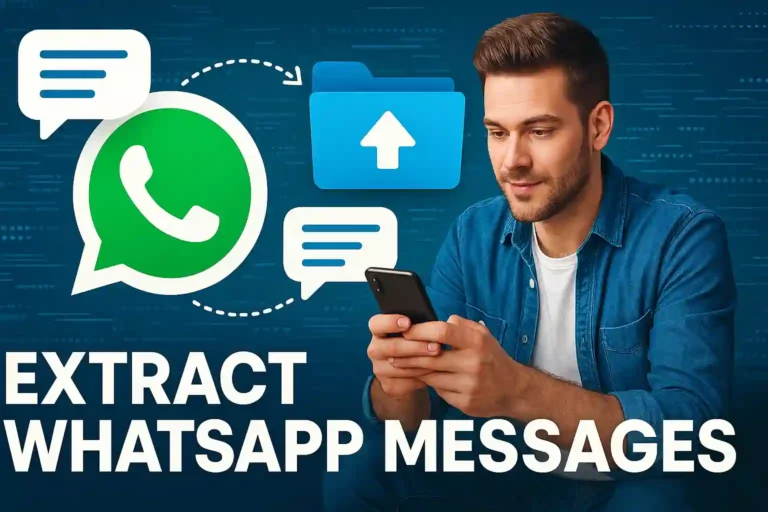How to Retrieve Deleted Text Messages on Android: complete guide
Your Android phone deleted important messages but understanding how to retrieve deleted text messages on Android helps.
Learn which Google Drive backups contain your texts and which recovery apps actually restore conversations safely.
Start exploring these recovery techniques today and regain access to your lost conversations without technical expertise.
Understanding Android Message Storage and Recovery Basics
Android devices store text messages in a dedicated database that doesn’t immediately delete content when you remove conversations from your messaging app interface.
The system marks deleted messages as recoverable until new data overwrites the storage space, creating a recovery window that varies by device usage patterns.
Understanding this process helps you act quickly when you need to recover texts from android, as immediate action significantly improves your success chances.
Google Backup: Your First Line of Defense
Google’s automatic backup system represents the most reliable method for android SMS restore, backing up messages to your Google Drive account regularly.
Most Android phones enable this feature by default, storing message data alongside app information, settings, and other critical device content automatically.
Accessing these backups requires factory resetting your device or using specific recovery procedures that restore your entire message database from cloud storage.
Checking Your Google Backup Status
Navigate to Settings > System > Backup to verify your backup configuration and see when your messages were last saved to Google’s servers.
Enable automatic backups if they’re disabled, though this won’t help with currently deleted messages but protects against future data loss scenarios.
The backup frequency depends on your Wi-Fi connection, charging status, and device idle time, typically occurring every 24 hours when conditions are met.
Restoring Messages from Google Backup
Factory reset your device and sign in with the same Google account to access backup restoration options during the initial setup process.
Select the most recent backup that contains your deleted messages, though this process replaces all current device data with the backup version.
This method works best when you discover missing messages shortly after deletion and have recent backups available for restoration.
Using Built-in Android Recovery Features
Modern Android versions include native recovery tools that can restore messages without third-party applications or complex technical procedures.
Samsung devices offer Smart Switch, LG phones include Bridge software, and stock Android provides Google One backup integration for comprehensive data recovery.
These manufacturer-specific tools often provide more granular control over what data gets restored compared to generic backup solutions available across all devices.
Samsung Smart Switch Recovery
Samsung users can leverage Smart Switch to transfer and restore data from previous backups stored locally or in Samsung Cloud storage systems.
The application allows selective restoration, meaning you can recover messages without affecting other device data like photos, apps, or system settings.
Connect your device to a computer running Smart Switch, then follow the restoration wizard to recover deleted text conversations from available backup sources.
Carrier-Specific Message Recovery
Major carriers like Verizon, AT&T, and T-Mobile sometimes store message data on their servers for billing and legal compliance purposes.
Contact your carrier’s customer service to inquire about message recovery services, though availability varies significantly between providers and account types.
This option typically requires a valid reason for recovery and may involve fees, but it can retrieve messages from much older time periods.
Third-Party Recovery Applications and Tools
Specialized recovery applications offer advanced features for retrieving deleted messages when built-in methods fail to produce results.
Learning how to retrieve deleted text messages on android through these tools often provides more comprehensive recovery options than standard backup restoration.
Popular applications include Dr.Fone, PhoneRescue, and GT Recovery, each offering different approaches to android phone message tool functionality and recovery success rates.
Dr.Fone for Android Recovery
Dr.Fone specializes in recovering various data types including messages, photos, contacts, and app data from Android devices with and without root access.
The software scans your device’s storage for recoverable message fragments, presenting them in an organized interface for selective restoration.
While some features require device rooting, Dr.Fone offers restore texts without root options for newer Android versions with enhanced security measures.
PhoneRescue Message Recovery
PhoneRescue provides android recovery without PC options through its mobile application, scanning device storage for deleted message databases.
The tool offers preview functionality, allowing you to see recoverable messages before committing to the restoration process.
Success rates vary based on how much time has passed since deletion and how much new data has been written to your device storage.
Messaging App-Specific Recovery Methods
Different messaging applications store data differently, requiring specific approaches for successful recovery of lost SMS android conversations.
WhatsApp, Telegram, and Facebook Messenger each offer built-in backup systems that operate independently of Android’s native message storage.
Understanding these app-specific recovery methods expands your options when dealing with messages from particular platforms rather than standard SMS conversations.
WhatsApp Chat Recovery
WhatsApp automatically creates local backups stored in your device’s internal storage, typically in the WhatsApp/Databases folder.
Uninstall and reinstall WhatsApp to trigger the restoration process, which will detect and offer to restore from the most recent backup file.
Google Drive backups provide additional recovery options, though you’ll need the same phone number and Google account used for the original backup.
Telegram and Signal Recovery
Telegram stores messages on cloud servers, making recovery as simple as logging into your account on a new device installation.
Signal requires manual backup creation, but once enabled, you can restore messages by importing the backup file during application setup.
These cloud-based messaging platforms often provide more reliable recovery options than traditional SMS messaging systems.
Advanced Recovery Techniques for Rooted Devices
Root access unlocks powerful recovery capabilities by providing direct access to Android’s file system and deleted data recovery tools.
Rooted devices can utilize SMS app data recovery methods that scan raw storage partitions for recoverable message fragments.
However, rooting voids warranties and can create security vulnerabilities, so consider these risks before pursuing advanced recovery methods.
Titanium Backup for Rooted Recovery
Titanium Backup offers comprehensive data recovery for rooted Android devices, including message databases and app-specific data.
The application can restore individual app data without affecting other system components, providing precise control over what gets recovered.
Regular backups through Titanium Backup create multiple restore points, allowing recovery from various time periods based on your backup schedule.
Direct Database Recovery Methods
Rooted devices allow direct access to the mmssms.db file where Android stores text message data, enabling manual database recovery.
SQLite database browsers can open these files and recover deleted entries that haven’t been overwritten by new data.
This method requires technical knowledge but offers the highest success rates for message retriever android functionality when other methods fail.
Prevention Strategies and Best Practices
Implementing proactive backup strategies prevents future message loss and reduces dependence on complex recovery procedures.
Regular backups to multiple locations, including cloud storage and local copies, ensure you always have recent message archives available.
Understanding how to retrieve deleted text messages on android includes knowing how to prevent loss in the first place through proper backup configuration.
Automated Backup Configuration
Configure automatic backups through Google Drive, Samsung Cloud, or other manufacturer-specific services to ensure regular message preservation.
Set backup frequency to daily or weekly based on your message volume and the importance of maintaining current conversation archives.
Enable backup over Wi-Fi only to avoid cellular data charges, but ensure your device connects to Wi-Fi regularly for backup completion.
Third-Party Backup Solutions
Consider dedicated messaging backup applications that create local copies of your conversations independent of manufacturer backup systems.
SMS Backup & Restore creates exportable files that can be stored on various cloud services or local storage devices for redundancy.
These solutions often provide more flexibility in backup timing and storage location compared to built-in Android backup systems.
Troubleshooting Common Recovery Issues
Recovery attempts sometimes fail due to technical limitations, storage overwriting, or incompatible backup formats between different Android versions.
Understanding common failure points helps you adjust your recovery approach and explore alternative methods when initial attempts don’t succeed.
Successful deleted text data tools usage often requires trying multiple approaches before finding the method that works for your specific situation.
Storage Overwriting Problems
New data constantly overwrites deleted message storage locations, reducing recovery chances as time passes after deletion.
Minimize device usage immediately after discovering deleted messages to prevent storage overwriting and maintain recovery possibilities.
Enable airplane mode to stop new data from being written to storage, though this prevents backup access that might also contain your deleted messages.
Compatibility and Version Issues
Different Android versions store message data in varying formats, sometimes creating compatibility issues between backup and recovery systems.
Newer security features in recent Android versions may prevent some recovery tools from accessing message databases without root access.
Consider using manufacturer-specific recovery tools that are designed to work with your particular device model and Android version.
Conclusion
Successfully recovering deleted text messages requires understanding multiple recovery approaches, from built-in backup systems to specialized recovery applications.
The key to effective how to retrieve deleted text messages on android lies in acting quickly and trying multiple methods until you find success.
Implementing preventive backup strategies ensures future message security while maintaining recovery options for unexpected deletion scenarios.
Frequently Asked Questions
Can I recover deleted text messages without any backup?
Yes, third-party recovery tools can scan device storage for deleted message fragments, though success rates decrease over time.
How long do deleted messages remain recoverable on Android?
Recovery windows vary from hours to weeks depending on device usage, storage capacity, and new data being written to storage.
Do I need to root my Android device for message recovery?
No, many recovery methods work without root access, including Google backup restoration and some third-party recovery applications.
Will factory reset help recover my deleted messages?
Factory reset only helps if you restore from a backup that contains your deleted messages, otherwise it permanently removes all data.
Are there any free options for recovering deleted Android messages?
Yes, Google backup restoration is free, and some recovery apps offer limited free recovery options before requiring payment.






